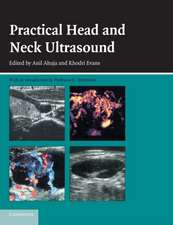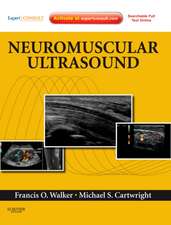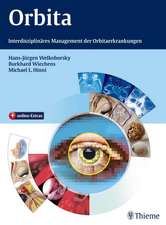Translational Neuroimaging: Tools for CNS Drug Discovery, Development and Treatment
Editat de Robert A. McArthuren Limba Engleză Hardback – 13 dec 2012
- Provides a background to translational research and the use of brain imaging in neuropsychiatric disorders
- Critical discussion of the potential and limitations of neuroimaging as a translational tool for identifying and validating biomarkers
- Identifies cross species neurosystems and common endpoints necessary to help accelerate CNS drug discovery and development for the treatment of neuropsychiatric disorders
Preț: 814.23 lei
Preț vechi: 1013.68 lei
-20% Nou
Puncte Express: 1221
Preț estimativ în valută:
155.82€ • 169.20$ • 130.89£
155.82€ • 169.20$ • 130.89£
Carte tipărită la comandă
Livrare economică 15-29 aprilie
Preluare comenzi: 021 569.72.76
Specificații
ISBN-13: 9780123869456
ISBN-10: 0123869455
Pagini: 464
Ilustrații: illustrations
Dimensiuni: 191 x 235 x 27 mm
Editura: ELSEVIER SCIENCE
ISBN-10: 0123869455
Pagini: 464
Ilustrații: illustrations
Dimensiuni: 191 x 235 x 27 mm
Editura: ELSEVIER SCIENCE
Public țintă
Primary Market: Researchers in the biopharmaceutical industry and academic who actively work on CNS drug treatment studies, often found in molecular biology, pharmacology, neuroscience, and psychiatry departments drug delivery groups, as well as, researchers using animal models to study drug development and therapeutics.Secondary Market: Graduate students, postdocs and professors at medical schools studying translational medicine.
Cuprins
Preface
Chapter 1: Neuroimaging Modalities: Description, Comparisons, Strengths and Weaknesses
Chapter 2: Magnetic Resonance Imaging as a Tool for Modelling Drug Treatment of CNS Disorders: Strengths and Weaknesses
Chapter 3: Small Animal Imaging as a Tool For Modelling CNS disorders: Strengths and Weaknesses
Chapter 4: Structural Magnetic Resonance Imaging as a Biomarker for the Diagnosis, Progression, and Treatment of Alzheimer’s Disease
Chapter 5: Positron Emission Tomography in Alzheimer’s disease: Diagnosis and Use as Biomarker Endpoints
Chapter 6: Rethinking the Contribution of Neuroimaging to Translation in Schizophrenia.
Chapter 7: Neuroimaging as a Translational Tool in Animal and Human Models of Schizophrenia
Chapter 8: Functional Magnetic Resonance Imaging as a Biomarker for the Diagnosis, Progression and Treatment of Autistic Spectrum Disorders
Chapter 9: Translational Neuroimaging for Drug Discovery and Development in Autism Spectrum Disorders: Guidance from Clinical Imaging and Preclinical Research
Chapter 10: Neuroimaging as a Biomarker for the Diagnosis, Progression and Treatment of Substance Abuse Disorder
Chapter 11: Translational Neuroimaging: Substance Abuse Disorders
Chapter 12: Neuroimaging Approaches to the Understanding of Depression and the Identification of Novel Antidepressants
Chapter 1: Neuroimaging Modalities: Description, Comparisons, Strengths and Weaknesses
Chapter 2: Magnetic Resonance Imaging as a Tool for Modelling Drug Treatment of CNS Disorders: Strengths and Weaknesses
Chapter 3: Small Animal Imaging as a Tool For Modelling CNS disorders: Strengths and Weaknesses
Chapter 4: Structural Magnetic Resonance Imaging as a Biomarker for the Diagnosis, Progression, and Treatment of Alzheimer’s Disease
Chapter 5: Positron Emission Tomography in Alzheimer’s disease: Diagnosis and Use as Biomarker Endpoints
Chapter 6: Rethinking the Contribution of Neuroimaging to Translation in Schizophrenia.
Chapter 7: Neuroimaging as a Translational Tool in Animal and Human Models of Schizophrenia
Chapter 8: Functional Magnetic Resonance Imaging as a Biomarker for the Diagnosis, Progression and Treatment of Autistic Spectrum Disorders
Chapter 9: Translational Neuroimaging for Drug Discovery and Development in Autism Spectrum Disorders: Guidance from Clinical Imaging and Preclinical Research
Chapter 10: Neuroimaging as a Biomarker for the Diagnosis, Progression and Treatment of Substance Abuse Disorder
Chapter 11: Translational Neuroimaging: Substance Abuse Disorders
Chapter 12: Neuroimaging Approaches to the Understanding of Depression and the Identification of Novel Antidepressants
Recenzii
"This book examines how neuroimaging can play a role in translational research by developing preclinical models and ultimately clinical studies for drug discovery." --Doody.com, October 17, 2013
"Researchers in imaging technology, neurology, and mental health sciences introduce fundamental concepts of neuroimaging, the various modalities being used, how it is being used to study central nervous system (CNS) disorders, and specifically how it is being used to discover and develop drugs for such disorders." --Reference & Research Book News, October 2013
"Researchers in imaging technology, neurology, and mental health sciences introduce fundamental concepts of neuroimaging, the various modalities being used, how it is being used to study central nervous system (CNS) disorders, and specifically how it is being used to discover and develop drugs for such disorders." --Reference & Research Book News, October 2013



